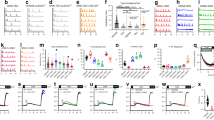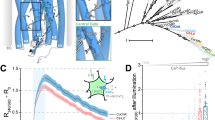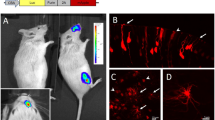Abstract
An important mechanism by which vertebrate olfactory sensory neurons rapidly adapt to odorants is feedback modulation of the Ca2+-permeable cyclic nucleotide–gated (CNG) transduction channels. Extensive heterologous studies of homomeric CNGA2 channels have led to a molecular model of channel modulation based on the binding of calcium-calmodulin to a site on the cytoplasmic amino terminus of CNGA2. Native rat olfactory CNG channels, however, are heteromeric complexes of three homologous but distinct subunits. Notably, in heteromeric channels, we found no role for CNGA2 in feedback modulation. Instead, an IQ-type calmodulin-binding site on CNGB1b and a similar but previously unidentified site on CNGA4 are necessary and sufficient. These sites seem to confer binding of Ca2+-free calmodulin (apocalmodulin), which is then poised to trigger inhibition of native channels in the presence of Ca2+.
This is a preview of subscription content, access via your institution
Access options
Subscribe to this journal
Receive 12 print issues and online access
$209.00 per year
only $17.42 per issue
Buy this article
- Purchase on Springer Link
- Instant access to full article PDF
Prices may be subject to local taxes which are calculated during checkout




Similar content being viewed by others
References
Frings, S. Chemoelectrical signal transduction in olfactory sensory neurons of air- breathing vertebrates. Cell Mol. Life Sci. 58, 510–609 (2001).
Kurahashi, T. & Shibuya, T. Ca2+-dependent adaptive properties in the solitary olfactory receptor cell of the newt. Brain Res. 515, 261–268 (1990).
Kurahashi, T. & Menini, A. Mechanism of odorant adaptation in the olfactory receptor cell. Nature 385, 725–729 (1997).
Chen, T.Y. & Yau, K.W. Direct modulation by Ca2+-calmodulin of cyclic nucleotide-activated channel of rat olfactory receptor neurons. Nature 368, 545–548 (1994).
Liu, M., Chen, T.Y., Ahamed, B., Li, J. & Yau, K.W. Calcium-calmodulin modulation of the olfactory cyclic nucleotide-gated cation channel. Science 266, 1348–1354 (1994).
Varnum, M.D. & Zagotta, W.N. Interdomain interactions underlying activation of cyclic nucleotide-gated channels. Science 278, 110–113 (1997).
Grunwald, M.E., Zhong, H., Lai, J. & Yau, K.W. Molecular determinants of the modulation of cyclic nucleotide-activated channels by calmodulin. Proc. Natl. Acad. Sci. USA 96, 13444–13449 (1999).
Zheng, J., Varnum, M.D. & Zagotta, W.N. Disruption of an intersubunit interaction underlies Ca2+-calmodulin modulation of cyclic nucleotide-gated channels. J. Neurosci. 23, 8167–8175 (2003).
Trudeau, M.C. & Zagotta, W.N. Calcium/calmodulin modulation of olfactory and rod cyclic nucleotide-gated ion channels. J. Biol. Chem. 278, 18705–18708 (2003).
Bradley, J., Reuter, D. & Frings, S. Facilitation of calmodulin-mediated odor adaptation by cAMP-gated channel subunits. Science 294, 2176–2178 (2001).
Bönigk, W. et al. The native rat olfactory cyclic nucleotide-gated channel is composed of three distinct subunits. J. Neurosci. 19, 5332–5347 (1999).
Bradley, J., Frings, S., Yau, K.W. & Reed, R. Nomenclature for ion channel subunits. Science 294, 2095–2096 (2001).
Sautter, A., Zong, X., Hofmann, F. & Biel, M. An isoform of the rod photoreceptor cyclic nucleotide-gated channel β subunit expressed in olfactory neurons. Proc. Natl. Acad. Sci. USA 95, 4696–4701 (1998).
Munger, S.D. et al. Central role of the CNGA4 channel subunit in Ca2+-calmodulin-dependent odor adaptation. Science 294, 2172–2175 (2001).
Kaupp, U.B. & Seifert, R. Cyclic nucleotide-gated ion channels. Physiol. Rev. 82, 769–824 (2002).
Frings, S., Lynch, J.W. & Lindemann, B. Properties of cyclic nucleotide-gated channels mediating olfactory transduction. Activation, selectivity, and blockage. J. Gen. Physiol. 100, 45–67 (1992).
Lynch, J.W. & Lindemann, B. Cyclic nucleotide-gated channels of rat olfactory receptor cells: divalent cations control the sensitivity to cAMP. J. Gen. Physiol. 103, 87–106 (1994).
Kramer, R.H. & Siegelbaum, S.A. Intracellular Ca2+ regulates the sensitivity of cyclic nucleotide-gated channels in olfactory receptor neurons. Neuron 9, 897–906 (1992).
Kleene, S.J. Both external and internal calcium reduce the sensitivity of the olfactory cyclic-nucleotide-gated channel to CAMP. J. Neurophysiol. 81, 2675–2682 (1999).
Anholt, R.R. & Rivers, A.M. Olfactory transduction: cross-talk between second-messenger systems. Biochemistry 29, 4049–4054 (1990).
O'Neil, K.T. & DeGrado, W.F. How calmodulin binds its targets: sequence independent recognition of amphiphilic α-helices. Trends. Biochem. Sci. 15, 59–64 (1990).
Grunwald, M.E., Yu, W.P., Yu, H.H. & Yau, K.W. Identification of a domain on the beta-subunit of the rod cGMP-gated cation channel that mediates inhibition by calcium-calmodulin. J. Biol. Chem. 273, 9148–9157 (1998).
Weitz, D. et al. Calmodulin controls the rod photoreceptor CNG channel through an unconventional binding site in the N-terminus of the beta-subunit. EMBO J. 17, 2273–2284 (1998).
Bahler, M. & Rhoads, A. Calmodulin signaling via the IQ motif. FEBS Letters 513, 107–113 (2002).
Erickson, M.G., Liang, H., Mori, M.X. & Yue, D.T. FRET two-hybrid mapping reveals function and location of L-type Ca2+ channel CaM preassociation. Neuron 39, 97–107 (2003).
Zuhlke, R.D., Pitt, G.S., Tsien, R.W. & Reuter, H. Ca2+-sensitive inactivation and facilitation of L-type Ca2+ channels both depend on specific amino acid residues in a consensus calmodulin-binding motif in the α1C subunit. J. Biol. Chem. 275, 21121–21129 (2000).
Yap, K.L. et al. Calmodulin target database. J. Struct. Funct. Genomics 1, 8–14 (2000).
Peng, C., Rich, E.D., Thor, C.A. & Varnum, M.D. Functionally important calmodulin binding sites in both N- and C-terminal regions of the cone photoreceptor cyclic nucleotide-gated channel CNGB3 subunit. J. Biol. Chem. 278, 24617–24623 (2003).
Sencer, S. et al. Coupling of RYR1 and L-type calcium channels via calmodulin binding domains. J. Biol. Chem. 276, 38237–38241 (2001).
Leinders-Zufall, T., Rand, M.N., Shepherd, G.M., Greer, C.A. & Zufall, F. Calcium entry through cyclic nucleotide-gated channels in individual cilia of olfactory receptor cells: spatiotemporal dynamics. J. Neurosci. 17, 4136–4148 (1997).
Orsale, M. et al. Two distinct calcium-calmodulin interactions with N-terminal regions of the olfactory and rod cyclic nucleotide-gated channels characterized by NMR spectroscopy. FEBS Letters 548, 11–16 (2003).
Acknowledgements
We thank J. Reisert and V. Bhandawat for many discussions; J. Kehoe, B. Barbour, N. Pardigon, J. Lynch, S. Hattar, R. Kuruvilla and P. Bauer for comments; P. Ascher for critically reading the manuscript and V. Kefelov for suggesting the experiment for Figure 2c. J.B. dedicates this paper to Norman Davidson. This work was supported by the Deutsche Forschungsgemeinschaft under grant SPP 1025 (S.F.) and by the Howard Hughes Medical Institute (J.B. & K.-W.Y.).
Author information
Authors and Affiliations
Corresponding authors
Ethics declarations
Competing interests
The authors declare no competing financial interests.
Rights and permissions
About this article
Cite this article
Bradley, J., Bönigk, W., Yau, KW. et al. Calmodulin permanently associates with rat olfactory CNG channels under native conditions. Nat Neurosci 7, 705–710 (2004). https://doi.org/10.1038/nn1266
Received:
Accepted:
Published:
Issue Date:
DOI: https://doi.org/10.1038/nn1266
This article is cited by
-
The cyclic AMP signaling pathway in the rodent main olfactory system
Cell and Tissue Research (2021)
-
Olfactory marker protein directly buffers cAMP to avoid depolarization-induced silencing of olfactory receptor neurons
Nature Communications (2020)
-
Contribution of the cyclic nucleotide gated channel subunit, CNG-3, to olfactory plasticity in Caenorhabditis elegans
Scientific Reports (2017)
-
Deciphering the function of the CNGB1b subunit in olfactory CNG channels
Scientific Reports (2016)
-
Resonance assignments and secondary structure of calmodulin in complex with its target sequence in rat olfactory cyclic nucleotide-gated ion channel
Biomolecular NMR Assignments (2014)



